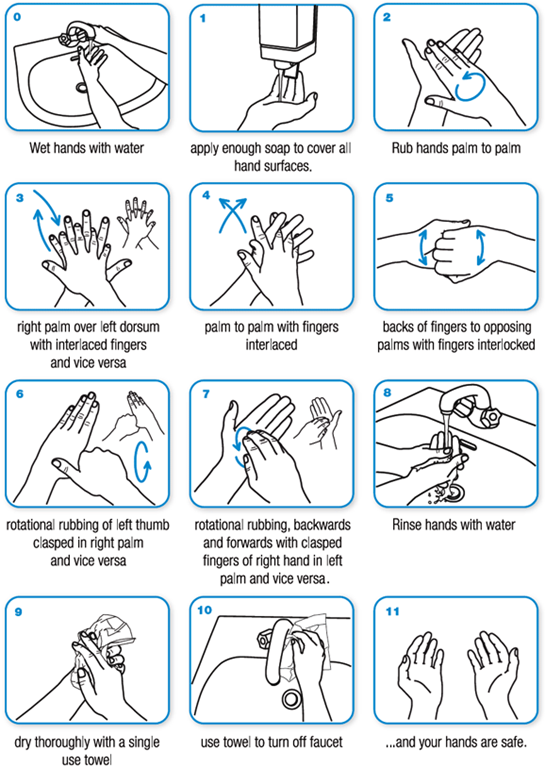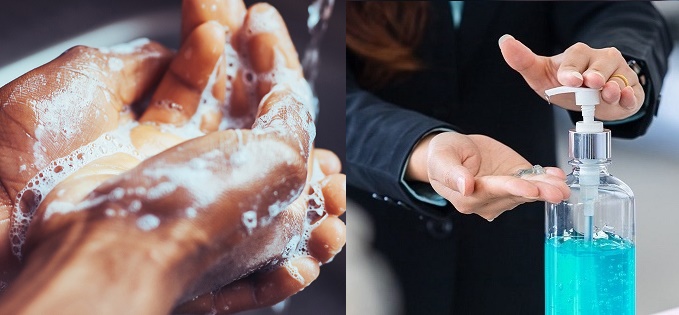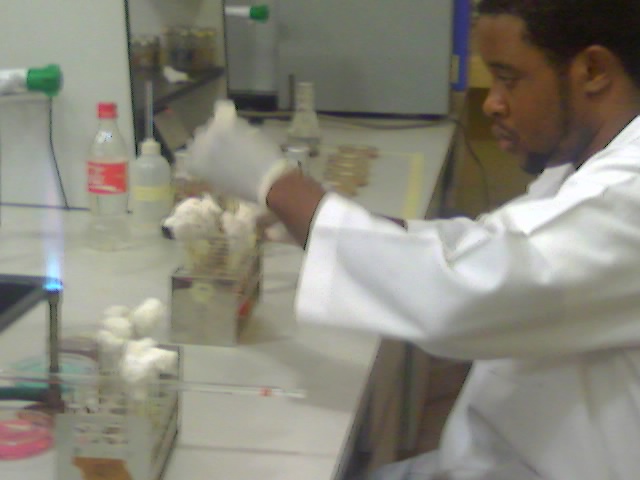- Hand washing: Hand washing is a very important personal hygiene technique that is often overlooked by not just microbiology laboratory personnel’s, but by so many people. Good hand washing technique (Figure 1) using antiseptics or soap is the best way to prevent the spread of germs. Microbiology laboratory personnel’s should always wash their hands before and after handling and processing patient’s specimens and before leaving the laboratory as well. As a way of prevention, hand washing is recommended for everybody as a measure geared towards keeping pathogenic microorganisms at bay. Proper hand washing technique is critical for infection control measures, and it is invaluable for the prevention of contamination and spread of infectious agents in the microbiology laboratory. It is a surest way of keeping germs (i.e. microorganisms) at bay; and hand washing should be practiced by microbiologists and students working in the laboratory since microorganisms are ubiquitous and can become pathogenic when they gain entry into the body especially via dirty and contaminated hands.

- Eating, drinking, and smoking in the microbiology laboratory should be discouraged and should not be allowed to take place.
- Gloves should always be worn before handling and processing of any specimen. It should also be worn when touching non – intact skin of patients and gloves should be changed after contact with each patient.
- Aseptic technique should be used when handling and processing patient’s specimens.
- Laboratory gowns should always be worn when inside the laboratory and working on patients specimens, and such protective clothing’s should be removed before leaving the microbiology laboratory.
- All working area in the microbiology laboratory should be adequately disinfected using disinfectants immediately after work.
- Masks, eye goggles or full – face shields should be worn whenever handling specimens with a possibility of producing aerosols.
- Because medical history and physical examination cannot effectively decipher all patients infected with HIV or other blood – borne pathogens like hepatitis virus, microbiology laboratory personnel’s should consider all clinical specimen’s infectious, and they should be handled appropriately.
- Food should not be taken into the microbiology laboratory because of its possible contamination.
- Mouth pipetting should not be allowed in the microbiology laboratory. Mechanical pipetting devices should be used for the manipulation of all liquids in the laboratory.
- Syringes and needles should be changed for each patient’s and after use; they should be emptied into a puncture resistant container without necessarily recapping the needles.
- All waste from the microbiology laboratory should be emptied into air tight containers until their decontamination and disposal.
REFERENCES
Atlas R.M (2010). Handbook of Microbiological Media. Fourth edition. American Society of Microbiology Press, USA.
Balows A, Hausler W, Herrmann K.L, Isenberg H.D and Shadomy H.J (1991). Manual of clinical microbiology. 5th ed. American Society of Microbiology Press, USA.
Beers M.H., Porter R.S., Jones T.V., Kaplan J.L and Berkwits M (2006). The Merck Manual of Diagnosis and Therapy. Eighteenth edition. Merck & Co., Inc, USA.
Black, J.G. (2008). Microbiology: Principles and Explorations (7th ed.). Hoboken, NJ: J. Wiley & Sons.
Brooks G.F., Butel J.S and Morse S.A (2004). Medical Microbiology, 23rd edition. McGraw Hill Publishers. USA. Pp. 248-260.
Dictionary of Microbiology and Molecular Biology, 3rd Edition. Paul Singleton and Diana Sainsbury. 2006, John Wiley & Sons Ltd. Canada.
Dubey, R. C. and Maheshwari, D. K. (2004). Practical Microbiology. S.Chand and Company LTD, New Delhi, India.
Garcia L.S (2010). Clinical Microbiology Procedures Handbook. Third edition. American Society of Microbiology Press, USA.
Garcia L.S (2014). Clinical Laboratory Management. First edition. American Society of Microbiology Press, USA.
Madigan M.T., Martinko J.M., Dunlap P.V and Clark D.P (2009). Brock Biology of Microorganisms, 12th edition. Pearson Benjamin Cummings Inc, USA.
Mahon C. R, Lehman D.C and Manuselis G (2011). Textbook of Diagnostic Microbiology. Fourth edition. Saunders Publishers, USA.
Prescott L.M., Harley J.P and Klein D.A (2005). Microbiology. 6th ed. McGraw Hill Publishers, USA. Pp. 296-299.
Ryan K, Ray C.G, Ahmed N, Drew W.L and Plorde J (2010). Sherris Medical Microbiology. Fifth edition. McGraw-Hill Publishers, USA.
Salyers A.A and Whitt D.D (2001). Microbiology: diversity, disease, and the environment. Fitzgerald Science Press Inc. Maryland, USA.
Discover more from #1 Microbiology Resource Hub
Subscribe to get the latest posts to your email.



